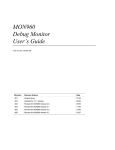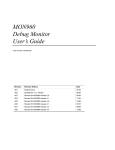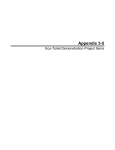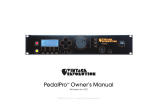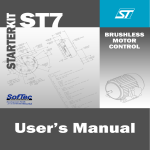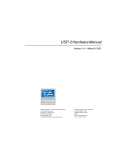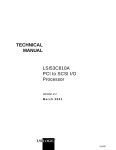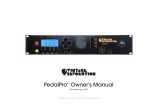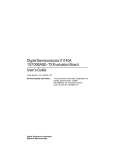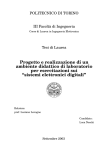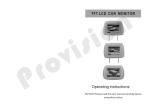Download SCSI/Ethernet IQ Module
Transcript
SCSI/Ethernet IQ Module Board Manual March 1998 Order Number: 272924-003 Information in this document is provided in connection with Intel products. No license, express or implied, by estoppel or otherwise, to any intellectual property rights is granted by this document. Except as provided in Intel’s Terms and Conditions of Sale for such products, Intel assumes no liability whatsoever, and Intel disclaims any express or implied warranty, relating to sale and/or use of Intel products including liability or warranties relating to fitness for a particular purpose, merchantability, or infringement of any patent, copyright or other intellectual property right. Intel products are not intended for use in medical, life saving, or life sustaining applications. Intel may make changes to specifications and product descriptions at any time, without notice. Designers must not rely on the absence or characteristics of any features or instructions marked "reserved" or "undefined." Intel reserves these for future definition and shall have no responsibility whatsoever for conflicts or incompatibilities arising from future changes to them. The IQ Module may contain design defects or errors known as errata which may cause the product to deviate from published specifications. Current characterized errata are available on request. Contact your local Intel sales office or your distributor to obtain the latest specifications and before placing your product order. Copies of documents which have an ordering number and are referenced in this document, or other Intel literature may be obtained by calling 1-800548-4725 or by visiting Intel’s website at http://www.intel.com. Copyright © Intel Corporation, 1998 *Third-party brands and names are the property of their respective owners. SCSI/Ethernet IQ Module Board Manual Contents 1 Introduction ................................................................................................................................1-1 1.1 1.2 1.3 1.4 2 Overview................................................................................................................................... 1-1 Features.................................................................................................................................... 1-1 Specifications............................................................................................................................ 1-1 Related Information .................................................................................................................. 1-2 1.4.1 Ordering Information .....................................................................................................1-2 1.4.2 Third-Party Vendor Contact Information .......................................................................1-2 1.4.3 Intel Documentation ......................................................................................................1-2 1.4.4 "Electronic" Information ................................................................................................1-3 1.4.5 Intel Customer Support Contacts..................................................................................1-3 Installation ..................................................................................................................................2-1 2.1 2.2 3 Installation On A Host ............................................................................................................... 2-1 Jumper Configuration ............................................................................................................... 2-1 Hardware Description ............................................................................................................3-1 3.1 3.2 3.3 3.4 3.5 3.6 3.7 3.8 3.9 3.10 3.11 4 4.1 4.2 4.3 4.4 5 5.1 5.2 5.3 5.4 5.5 5.6 Introduction ............................................................................................................................... 3-1 Specifications............................................................................................................................ 3-2 Ethernet Ports........................................................................................................................... 3-2 82557 Ethernet Controller......................................................................................................... 3-2 DP83840 and DP83223 Physical Layer Devices...................................................................... 3-3 Ethernet Port LEDs................................................................................................................... 3-3 Ethernet Port Connectors ......................................................................................................... 3-3 SCSI Ports ................................................................................................................................ 3-3 53C875 SCSI Controller ........................................................................................................... 3-4 SCSI Port Connectors .............................................................................................................. 3-4 SCSI Port Termination .............................................................................................................. 3-4 Programming Information ....................................................................................................4-1 Introduction ............................................................................................................................... 4-1 Ethernet Ports........................................................................................................................... 4-1 Ethernet Address Assignments ................................................................................................ 4-2 SCSI Ports ................................................................................................................................ 4-3 Connectors .................................................................................................................................5-1 SCSI/Ethernet IQ Module Connector........................................................................................ 5-1 Ethernet Port Connectors ......................................................................................................... 5-3 SCSI Port Connectors .............................................................................................................. 5-3 Assembly Drawing .................................................................................................................... 5-4 SCSI/Ethernet IQ Module Board Components ......................................................................... 5-5 SCSI/Ethernet IQ Module Bill of Materials................................................................................ 5-6 SCSI/Ethernet IQ Module Board Manual iii Figures 2-1 2-2 3-1 5-1 SCSI/Ethernet IQ Module Installation on Host ..........................................................................2-2 Host (left) and SCSI/Ethernet IQ Module (right) ........................................................................2-3 SCSI/Ethernet IQ Module Block Diagram..................................................................................3-1 SCSI/Ethernet IQ Module Assembly Drawing ...........................................................................5-4 Tables 1-1 1-2 1-3 1-4 3-1 3-2 4-1 5-1 5-2 5-3 5-4 5-5 iv Related Third-Party Information ................................................................................................1-2 Related Intel Documentation .....................................................................................................1-2 Related Electronic Information ..................................................................................................1-3 Intel Customer Support Telephone Numbers ............................................................................1-3 SCSI/Ethernet IQ Module Interface Signal Assignment ............................................................3-2 SCSI/Ethernet IQ Module Power Requirements .......................................................................3-2 Device Number Assignment ......................................................................................................4-1 SCSI/Ethernet IQ Module Connector Pinout .............................................................................5-1 100BaseTx Connector ...............................................................................................................5-3 SCSI Port Connectors ...............................................................................................................5-3 SCSI/Ethernet IQ Module, Component Description ..................................................................5-5 SCSI/Ethernet IQ Module, Bill of Materials................................................................................5-6 SCSI/Ethernet IQ Module Board Manual Introduction 1.1 1 Overview The SCSI/Ethernet IQ Module extends the I/O capabilities of its host board by providing two Ethernet and two SCSI ports. The SCSI/Ethernet IQ Module connects to the IQ Module Interface on the host board. The module may be hosted on an Intel IQ80960RP PCI card. The IQ Module Interface supports up to four PCI devices. The standard signals defined for 32-bit PCI edge connectors are used for IQ Modules, with some exceptions. See the IQ80960RP Evaluation Platform User’s Guide for more information on the IQ Module Interface. 1.2 Features • Two 10/100BaseTx type Ethernet ports, based on Intel’s 82557 Fast Ethernet PCI Bus Controller, National Semiconductor’s DP83840 Ethernet Physical Layer Device and National Semiconductor’s DP83228 High Speed Networking Transceiver. • Two 16-bit Ultra SCSI (40 Mbps) SCSI ports based on the Symbios Logic* SYM53C875 PCI-SCSI I/O Processor with UltraSCSI. 1.3 Specifications Host Clock Signal: • 33 MHz Maximum Physical Characteristics: • Length x Width x Height: 7.00" x 4.25" x 0.625" • Occupies only one IQ Module Location • Occupies only one PCI slot when installed on a PCI host SCSI/Ethernet IQ Module Board Manual 1-1 Introduction 1.4 Related Information 1.4.1 Ordering Information When ordering the SCSI/Ethernet IQ Module, refer to the module’s product code name "IQSCSIFENET". 1.4.2 Third-Party Vendor Contact Information In addition to the printed technical documentation — the "traditional" collection of product information — Intel is providing technical (and other) information to you electronically via FaxBACK, Application Bulletin Board Service (BBS) and Worlwide Web (WWW). The following subsections identify related technical information, sources for electronic file download, and technical support. Table 1-1. Related Third-Party Information Company Product Contact Symbios Logic SYM53C875 PCI-SCSI I/O Processor with UltraSCSI Data Manual PCI Special Interest Group PCI Local Bus Specification Revision 2.1 (800) 334-5454 (800) 433-5177 (US) (503) 693-6232 (Int’l) (503) 693-8344 (FAX) National Semiconductor 1.4.3 DP83840 Ethernet Physical Layer Device DP83223 High Speed Networking Transceiver (800) 272-9959 Intel Documentation Documentation is available from you local Intel Sales Representative or Intel Literature Sales. Intel Corporation PO Box 5937 Denver, CO 80217-9808 (800) 548-4725 Table 1-2. Related Intel Documentation Document Title IQ80960RP Evaluation Platform User’s Guide 1-2 Order # 272913 SCSI/Ethernet IQ Module Board Manual Introduction 1.4.4 "Electronic" Information Up-to-date product and technical information is available electronically from these sources. Table 1-3. Related Electronic Information Intel’s World-Wide Web (WWW) Location:1 http://www.intel.com/ FaxBACK Service: US and Canada Europe World-Wide 800-628-2283 +44(0)793-496646 916-356-3105 Application Bulletin Board Service: up to 14.4 Kbaud line, World-Wide 916-356-3600 dedicated 2400 Kbaud line, World-Wide 916-356-7209 Europe 1 1.4.5 +44(0)793-496340 Intel’s presence on the WWW is evolving rapidly; file locations may have changed after this manual was printed. If you are not finding the desired information, contact Customer Support for assistance. Intel Customer Support Contacts Table 1-4. Intel Customer Support Telephone Numbers Customer Support (US and Canada): Country 800-628-8686 Literature Technical Support Contact Local Distributor 61-2-975-3300 Australia National 008-257-307 Sydney Belgium, Netherlands, Luxembourg 61-3-810-2141 010-4071-111 010-4071-111 Canada 800-468-8118 Contact Local Distributor Finland 358-0-544-644 358-0-544-644 France 33-1-30-57-70-00 33-1-30-57-72-22 Germany 49-89-90992-257 Israel Hardware: 49-89-903-8529 Software: 49-89-903-2025 972-3-498080 972-3-548-3232 39-02-89200950 39-02-89200950 Contact Local Distributor 0120-1-80387 Sweden 46-8-7340100 46-8-7340100 United States 800-548-4725 800-628-8686 Italy Japan SCSI/Ethernet IQ Module Board Manual 1-3 Installation 2.1 Warning: 2 Installation On A Host Static discharge can severely damage integrated circuits. The host board and SCSI/Ethernet IQ Module should only be handled with proper static protection. SCSI/Ethernet IQ Modules should always be installed with power to the host board OFF. Mounting or dismounting a module with the host power ON could permanently damage the circuitry on the module. Refer to the SCSI/Ethernet IQ Module’s host board user’s manual for mounting locations. To install the SCSI/Ethernet IQ Module (Figure 2-1) proceed with the following steps: 1. Remove the corresponding blank mounting bracket from the host board. a. For PCI hosts, a PCI bracket for the SCSI/Ethernet IQ Module is supplied with the module. The PCI bracket is mounted to the host board using two small slotted screws, also supplied. 2. SCSI/Ethernet IQ Modules mount “face down”, that is, with the component side of the module facing the component side of the host. a. Hold the module upside down over the host board. b. Carefully tip the 10/100BaseTx connector of the module through the opening in the host mounting bracket. c. Rotate the opposite (120-pin connector) edge of the module downward. d. Align the module and host connectors. e. With the module and host aligned, press the two assemblies together, fully mating the connectors. 3. Secure the mounting hardware, four nylon screws hold the module to spacers on the host. 2.2 Jumper Configuration There are two jumpers on the SCSI/Ethernet IQ Module, located near the SCSI port connectors. Each jumper controls active termination for its SCSI port. The default position is ON, where termination is connected. See Chapter 3 for more information about SCSI port termination. See Chapter 5 for the location of the termination jumpers. SCSI/Ethernet IQ Module Board Manual 2-1 Installation Figure 2-1. SCSI/Ethernet IQ Module Installation on Host Replacement Mounting Bracket 10/100BaseTx Connector (angle down and through bracket opening before mating IQ module connectors) SCSI/Ethernet IQ Module Board Mounting Spacers IQ Module Connectors Host Board 2-2 SCSI/Ethernet IQ Module Board Manual SCSI/Ethernet IQ Module Board Manual i U25 FW80960RP-33 FFFFFFFF A0 MECHANICAL SAMPLE [M][C] 1994 ’ 5 I960® Frequency and VPP switches SW1 U3 U4 U1 U2 U5 Flash Memory IQ Module Connector 1234 Connect this edge connector to your system’s PCI slot J3 Emulator Connector J4 J6 J8 J1 CR3 CR4 J2 DRAM SIMM Attach SIMMs in connectors at 45° angle U22 U31 CR1 CR2 User LEDs (red) RS-232 Serial Port Installation Figure 2-2. Host (left) and SCSI/Ethernet IQ Module (right) OFF 2-3 3 Hardware Description 3.1 Introduction This chapter describes the hardware and general operation of the SCSI/Ethernet IQ Module. The VLSI circuits are not described in detail. The user should consult the manuals and data sheets listed in Section 1.4, “Related Information” on page 1-2, for a detailed description of these devices. Connectors are not covered in detail in this chapter, see Chapter 5, “Connectors”, for more information. Consult Chapter 4 for software and programming information. The SCSI/Ethernet IQ Module has four PCI devices, two PCI-Ethernet controllers and two PCI-SCSI controllers. The Ethernet controllers are Intel’s 82557 Fast Ethernet PCI Bus Controller. The SCSI controllers are Symbios Logic’s SYM53C875 PCI-SCSI I/O Processor with UltraSCSI. Figure 3-1. SCSI/Ethernet IQ Module Block Diagram IQ I/F Ethernet Controller Intel 82557 IQ I/F Ethernet Controller Intel 82557 IQ Module Connector Physical Ethernet Isolation Transformer MII Layer Device and I/F Transceiver DP83840 DP83223 Pulse* PE68515 Physical 10/100BaseTx Connector Ethernet Isolation Transformer MII Layer Device I/F and Transceiver DP83840 DP83223 Ethernet Port A Pulse PE68515 Ethernet Port B 10/100BaseTx Connector Active Termination IQ I/F SCSI Port A Ultra SCSI Controller 68 Pin SCSI Connector Symbios 53C875 Active Termination IQ I/F SCSI Port B Ultra SCSI Controller 68 Pin SCSI Connector Symbios 53C875 A block diagram of the SCSI/Ethernet IQ Module is shown in Figure 3-1. As the block diagram shows, all four ports are independent. To support up to four devices on the SCSI/Ethernet IQ Module interface, the host board supplies four clock, arbitration and interrupt signals to the IQ connector. Additionally, the host board does not provide IDSEL signals to the SCSI/Ethernet IQ Module interface for PCI configuration cycles. As shown in Table 3-1, the SCSI/Ethernet IQ Module connects AD16 through AD19 to IDSEL. The clock, arbitration, and interrupt resources are assigned as shown in Table 3-1. SCSI/Ethernet IQ Module Board Manual 3-1 Hardware Description Table 3-1. SCSI/Ethernet IQ Module Interface Signal Assignment SCSI/Ethernet IQ Module Port E-Net port A Clocking Arbitration CLK-A REQ0/GNT0 AD16 Interrupt IRQ-A E-Net port B CLK-B REQ1/GNT1 AD17 IRQ-B SCSI port A CLK-C REQ2/GNT2 AD18 IRQ-C SCSI port B CLK-D REQ3/GNT3 AD19 IRQ-D 3.2 Specifications Table 3-2. SCSI/Ethernet IQ Module Power Requirements Voltage 3.3 IDSEL Current Typical Current Maximum +3.3 V 0A 0A +5 V 4.05 A 5.11 A +12 V 0A 0A -12 V 0A 0A Ethernet Ports Both Ethernet ports are 10/100BaseTx type based on Intel’s 82557 Fast Ethernet PCI Bus Controller, National Semiconductor’s DP83840 Physical Layer Device and National Semiconductor’s DP83223 High Speed Networking Transceiver. The 82557 is the core component of the Ethernet interface. It uses a PCI bus interface to communicate with the host, and a MII (Media Independent Interface) to communicate with a physical layer device. 3.4 82557 Ethernet Controller The 82557 contains a 32-bit PCI bus master interface that interacts with the host memory to access data for transmission or deposit received data. The 82557 has large transmit and receive FIFOs that are unidirectional and independent of each other. The FIFOs provide temporary storage area for frames as they are received or transmitted. The FIFOs allow the 82557 to withstand long PCI latencies without losing incoming data or corrupting outgoing data. The interface on the 82557 for FLASH support is not used on the SCSI/Ethernet IQ Module. The EEPROM interface has a serial EEPROM attached and is used to store the port’s Ethernet address. 3-2 SCSI/Ethernet IQ Module Board Manual Hardware Description 3.5 DP83840 and DP83223 Physical Layer Devices The National Semiconductor DP83840 and DP83223 provide the physical layer interface function for a 100BaseTx or 10BaseT Ethernet network. The host side of the DP83840 connects to the Ethernet controller using the IEEE MII (Media Independent Interface). The DP83840 does not have a separate host interface; internal registers are accessed using the MII. The 100Mbps line side of the DP83840 connects to the DP83223 which in turn connects to the Ethernet isolation transformer. The 10Mbps line side of the DP83840 connects directly to the Ethernet isolation transformer. When receiving, the DP83840 and DP83223 physical layer pair recover data and clock from the incoming signals. The recovered data stream is then decoded and output to the Ethernet controller through the MII. When transmitting, the physical layer pair receive binary data from the MII, then encode and transmit that data to the network. The SCSI/Ethernet IQ Module configures the DP83840 to perform auto-negotiation per IEEE 802.3u. Auto-negotiation ensures that the highest performance protocol will be selected based on the ability of the SCSI/Ethernet IQ Module link partner. 3.6 Ethernet Port LEDs Each Ethernet port on the SCSI/Ethernet IQ Module has four LEDs driven by the DP83840 that provide a visual indication of network status: • The LED labeled “LNK” indicates link status. • The LED labeled "ACT" indicates network activity. The "ACT" LED blinks when there is transmit or receive activity. • The LED labeled "100" is on continuously when the port is connected to a 100 Mbps network. • The LED labeled "FDX" indicates full duplex mode status. The LED is on continuously when in full duplex mode. 3.7 Ethernet Port Connectors The Ethernet ports on the SCSI/Ethernet IQ Module connect to a dual, shielded RJ45 (modular phone type) connector that conforms to the 10/100BaseTx specification. The connector pin-out can be found in Chapter 5. The Ethernet ports are indicated on the SCSI/Ethernet IQ Modules front panel and on the assembly drawing in Chapter 5. 3.8 SCSI Ports Both SCSI ports are single-ended 16-bit UltraSCSI (40 Mbps) SCSI ports based on the Symbios Logic SYM53C875 PCI-SCSI I/O Processor with UltraSCSI. The 53C875 is the core component of the SCSI interface. It uses a PCI interface to communicate with the host and connects directly to the SCSI bus. SCSI/Ethernet IQ Module Board Manual 3-3 Hardware Description 3.9 53C875 SCSI Controller The 53C875 is an intelligent SCSI host adapter which includes a high performance SCSI core, a 32-bit PCI bus master DMA core and an integrated SCSI SCRIPTS processor. The SCSI core supports the 8- or 16-bit data bus. It supports UltraSCSI synchronous transfer rates up to 40 Mbps, SCSI-2 synchronous transfer rates up to 20 Mbps and asynchronous transfer rates up to 10 Mbps on a 16-bit SCSI bus. The 32-bit PCI bus master DMA core is tightly coupled to the SCSI core through the SCRIPTS processor, which supports uninterrupted scatter/gather memory operations. A 536 byte FIFO allows the 53C875 to support up to 128 longword bursts across the PCI interface. The SCRIPTS processor executes complex SCSI bus sequences independently of the host CPU. Algorithms written in SCSI SCRIPTS control the actions of the SCSI and DMA cores and are executed from the host boards RAM. 3.10 SCSI Port Connectors Each SCSI port connects to a 68-pin high density D-type connector on the top edge of the SCSI/Ethernet IQ Module PCB. These connectors conform to the "non-shielded connector" of the SCSI-2 and UltraSCSI extension of the SCSI-3 specification. The pin-out of these connectors conforms to the "connector contact assignments for the single ended primary bus" of the SCSI-2 and UltraSCSI extension of the SCSI-3 specification. The SCSI port connector pin-outs can be found in Chapter 5. 3.11 SCSI Port Termination The SCSI specification calls for all signals not defined as RESERVED, GROUND or TERMPWR to be terminated at each end of the cable. Additionally, the UltraSCSI extension of the SCSI-3 specification requires active termination in single ended UltraSCSI systems. The SCSI/Ethernet IQ Module uses an integrated active terminator device that has reduced line capacitance for operation at UltraSCSI transfer rates. If the SCSI/Ethernet IQ Module SCSI port is not at either end of the SCSI cable, then the termination must be disconnected. A two position jumper near each SCSI port connector is used to disconnect or turn off the active termination. The jumper shunt in the ON position connects the termination and the jumper shunt in the OFF position disconnects the termination. 3-4 SCSI/Ethernet IQ Module Board Manual 4 Programming Information 4.1 Introduction This chapter provides software and programming information for the SCSI/Ethernet IQ Module. This chapter does not contain a complete list of all registers in all devices. The user should consult the manuals and data sheets listed in Section 1.4, “Related Information” on page 1-2, for a detailed description of registers and configuration information. See Chapter 3 for hardware and general operation of the SCSI/Ethernet IQ Module. The SCSI/Ethernet IQ Module connects to the IQ Module Interface of its host board. The IQ Module Interface is a 32-bit PCI bus conforming to the PCI Local Bus Specification Revision 2.1, with exceptions noted in the host board users manual and Chapter 3. For PCI Type 0 configuration cycles, the device number assignment is as shown in Table 4-1. Table 4-1. Device Number Assignment SCSI/Ethernet IQ Module Port 4.2 IDSEL Device E-NET Port A AD16 Number 5 E-NET Port B AD17 Number 6 E-NET Port C AD18 Number 7 E-NET Port D AD19 Number 8 Ethernet Ports The 82557 establishes a shared memory communication system with the host CPU. This shared memory is divided into three parts: the Control/Status Registers (CSR), the Command Block List (CBL) and the Receive Frame Area (RFA). The CSR resides on-chip and can be accessed by either I/O or memory cycles, while the rest of the 82557 memory structures reside in system (host) memory. The first 8 bytes of the CSR is called the System Control Block (SCB). The SCB serves as a central communication point for exchanging control and status information between the host CPU and the 82557. The host software controls the state of the 82557 Command Unit (CU) and Receive Unit (RU) (for example Active, Suspended, Idle) by writing commands to the SCB. The 82557 posts the status of the CU and RU in the SCB Status word and indicates status changes with an interrupt. The SCB also holds pointers to a linked list of action commands called the CBL and a linked list of received resources called the RFA. Parameters which must be established prior to making the 82557 operational included internal configuration values (established using the Configure Command) and assigning an individual Ethernet address (using the Individual Address Setup Command). Note that the aforementioned shared memory communication architecture must be established prior to the execution of 82557 action commands. Refer to the 82557 manual for further information regarding device configuration. SCSI/Ethernet IQ Module Board Manual 4-1 Programming Information 4.3 Ethernet Address Assignments The ethernet address is pre-programmed at the factory and is stored in the on-board serial EEPROM. The following describes the ethernet address assignment. To provide a unique ethernet address for all IQ modules with Ethernet ports, an algorithm has been established that combines the IQ module number, the port number and the board’s serial number. The Ethernet address is a six byte number. The first three bytes are assigned to Cyclone Microsystems and are fixed at: $ 00 80 4D The last three bytes are broken into three binary fields: b XXXX XXXX YYZZ ZZZZ ZZZZ ZZZZ The first binary field, XXXX XXXX is the Module ID, in Hex. The SCSI/Ethernet IQ Module ID is 73 converted ($49). The second binary field, YY is the port number. For the SCSI/Ethernet IQ Module there are two ethernet ports: E-Net Port A, YY = 00 E-Net Port B, YY = 01 The third binary field, ZZ ZZZZ ZZZZ ZZZZ is the modules serial number converted to hex. For example, if the module serial number is 1234 then: 1234d = $4D2 ZZ ZZZZ ZZZZ ZZZZ = 00 0100 1101 0010 The complete ethernet address for an SCSI/Ethernet IQ Module with serial number 1234 would be: E-Net Port A = $ 00 80 4D 44 04 D2 E-Net Port B = $ 00 80 4D 49 44 D2 4-2 SCSI/Ethernet IQ Module Board Manual Programming Information 4.4 SCSI Ports This section defines specific setup requirements for the SYM53C875 processors to ensure proper operation of the SCSI/Ethernet IQ Module. To use Ultra SCSI capabilities of the SYM53C875, it is necessary to enable the clock doubler. This involves properly configuring registers STEST1 (register 4DH), STEST3 (register 4FH), and SCNTL1 (register 01H) of the SYM53C875. See the SYM53C875 PCI-SCSI I/O Processor with UltraSCSI Data Manual for further information. The default operating mode for the SCSI ports is 8-bit, 10 Mbps transfer rate. The SYM53C875 supports both wide-SCSI (16-bit) and Ultra SCSI, resulting in a maximum potential transfer rate of 40 Mbps (16-bit). Operation in wide and/or Ultra SCSI modes requires negotiation with the initiator or target. See the SCSI specification for the SCSI message system definition. The Synchronous Clock Conversion Factor bits SCF2, SCF1, and SCF0 (bits[6:4]) of SCSI Control Three Register (SCNTL3, register 03H) should be set to match the data transfer period negotiated with the target. For transfer periods of 100 ns or greater, set to 0,1,1 to divide the SCLK frequency of 80 MHz by 2 (for a 40 MHz clock input internally to the SYM53875). For transfer periods of less than 100 ns, set these bits to 0,0,1 to divide SCLK by 1. Set the Clock Conversion Factor bits CCF2, CCF1, and CCF0 (bits[2:0]) to 1,0,1. Note: The SCSI/Ethernet IQ Module uses a 40 MHz external SCLK which is doubled by the SYM53C875 to support UltraSCSI functions. Host bus parity checking should not be used. The MPEE bit (bit 3) of the Chip Test Four (CTEST4, register 21H) should be left at its default value of 0. The SCSI Differential Mode bit DIF (bit 5) of the SCSI Test Register 2 (STEST2, register 4EH) should be left at its default value of zero. The SCSI/Ethernet IQ Module uses the single-ended transceiver pins of the SYM53C875. SCSI/Ethernet IQ Module Board Manual 4-3 5 Connectors 5.1 SCSI/Ethernet IQ Module Connector IQ Modules use an AMP Champ 0.050" FH board-to-board connector with 120 pins. AMP plug P/N 176380-4 is located on the host platform and attaches to receptacle AMP P/N 176372-5. This connector combination allows for a 12 mm (0.472") board-to-board spacing. Table 5-1. SCSI/Ethernet IQ Module Connector Pinout Pin Signal Pin Signal 1 S_TRST 61 -12 V 2 +12 V 62 S_TCK 3 S_TMS 63 GND 4 S_TDI 64 N/C 5 +5 V 65 +5 V 6 S_INTA 66 +5 V 7 S_INTC 67 S_INTB 8 +5 V 68 S_INTD 9 CLK_C 69 S-REQ3 10 +5 V 70 S_REQ1 11 CLK_D 71 S_GNT3 12 GND 72 GND 13 GND 73 GND 14 S_GNT1 74 CLKA 15 S_RST 75 GND 16 +5 V 76 CLKB 17 S_GNT0 77 GND 18 GND 78 S_REQ0 19 S_REQ2 79 +5 V 20 S_AD30 80 S_AD31 21 3.3 V (1) 81 S_AD29 22 S_AD28 82 GND 23 S_AD26 83 S_AD27 24 GND 84 S_AD25 25 S_AD24 85 3.3 V (1) 26 S_GNT2 86 S_C/BE3 27 3.3 V (1) 87 S_AD23 28 S_AD22 88 GND SCSI/Ethernet IQ Module Board Manual 5-1 Connectors Table 5-1. SCSI/Ethernet IQ Module Connector Pinout (Continued) Pin Pin Signal 29 S_AD20 89 S_AD21 30 GND 90 S_AD19 31 S_AD18 91 3.3 V (1) 32 S_AD16 92 S_AD17 33 3.3 V (1) 93 S_C/BE2 34 S_FRAME 94 GND 35 GND 95 S_IRDY 36 S_TRDY 96 3.3 V (1) 37 GND 97 S_DEVSEL 38 S_STOP 98 GND 39 3.3 V (1) 99 S_LOCK 40 N/C 100 S_PERR 41 N/C 101 3.3 V (1) 42 GND 102 S_SERR 43 S_PAR 103 3.3 V (1) 44 S_AD15 104 S_C/BE1 45 3.3 V (1) 105 S_AD14 46 S_AD13 106 GND 47 S_AD11 107 S_AD12 48 GND 108 S_AD10 49 S_AD9 109 GND 50 S_C/BE0 110 S_AD8 51 3.3 V (1) 111 S_AD7 52 S_AD6 112 3.3 V (1) 53 S_AD4 113 S_AD5 54 GND 114 S_AD3 55 S_AD2 115 GND 56 S_AD0 116 S_AD1 57 +5 V 117 +5 V 58 N/C 118 N/C 59 +5 V 119 +5 V 60 +5 V 120 +5 V 1. 5-2 Signal 3.3 V pins are decoupled to ground with 0.01 µF capacitors to provide AC return paths. SCSI/Ethernet IQ Module Board Manual Connectors 5.2 Ethernet Port Connectors The Ethernet ports on the SCSI/Ethernet IQ Module connect to a dual, shielded RJ45 (modular phone type) connector that conforms to the 10/100BaseTx specification.The pinout for each Ethernet port is shown in Table 5-2. Table 5-2. 100BaseTx Connector Pin Signal Description 1 TX+ Output 2 TX- Output 3 RX+ Input 4 Not Used 5 Not Used 6 5.3 RX- Input 7 Not Used 8 Not Used SCSI Port Connectors Each SCSI port connects to a 68-pin high-density D-type connector on the top edge of the SCSI/Ethernet IQ Module. These connectors conform to the "non-shielded connector" of the SCSI-2 and UltraSCSI extension of the SCSI-3 specification. These connectors pinouts conform to the "connector contact assignments for the single ended primary bus" of the SCSI-2 and UltraSCSI extension of the SCSI-3 specification. The SCSI port connector pinout is shown in Table 5-3. Table 5-3. SCSI Port Connectors Pin Signal Pin Signal Pin Signal Pin Signal 1 Ground 35 -DB12 18 TERMPWR 52 TERMPWR 2 Ground 36 -DB13 19 N/C 53 N/C 3 Ground 37 -DB14 20 Ground 54 Ground 4 Ground 38 -DB15 21 Ground 55 -ATN 5 Ground 39 -DBP1 22 Ground 56 Ground 6 Ground 40 -DB0 23 Ground 57 -BSY 7 Ground 41 -DB1 24 Ground 58 -ACK 8 Ground 42 -DB2 25 Ground 59 -RST 9 Ground 43 -DB3 26 Ground 60 -MSG 10 Ground 44 -DB4 27 Ground 61 -SEL 11 Ground 45 -DB5 28 Ground 62 -C/D 12 Ground 46 -DB6 29 Ground 63 -REQ 13 Ground 47 -DB7 30 Ground 64 -I/O 14 Ground 48 -DBP0 31 Ground 65 -DB8 15 Ground 49 Ground 32 Ground 66 -DB9 16 Ground 50 Ground 33 Ground 67 -DB10 17 TERMPWR 51 TERMPWR 34 Ground 68 -DB11 SCSI/Ethernet IQ Module Board Manual 5-3 Connectors 5.4 Assembly Drawing The layout or assembly drawing is shown in Figure 5-1. This figure can be used to identify Ethernet Ports A & B and SCSI Ports A & B. This figure also shows the location of the SCSI terminator jumpers. Q1 Q4 Q3 CR1 CR2 TP1 TP2 C8 U6 + R11 R12 U7 L1 L2 C7 ETHERNET PORT B + R10 C6 U2 C5 R8 R5 U8 J1 U1 R7 U5 C4 ETHERNET PORT A R2 R3 U4 C3 R4 Q2 R9 R6 U13 C1 R1 C2 Figure 5-1. SCSI/Ethernet IQ Module Assembly Drawing + J2 SCSI PORT B TERMINATION CONTROL FOR SCSI PORT B 5-4 + U13 C14 R19 U17 F2 R22 U16 CR5 CR6 U15 R20 C11 C16 R23 U12 U18 J3 Z2 Z1 0307B ASSEMBLY TOP 270-0370-02 IQ70 C6 F1 Q8 U4 J4 U5 R9 R6 C12 Q7 C15 U14 Q6 R21 R14 Q5 R8 R5 TP4 R13 TP3 C10 CR3 CR4 C9 U9 SCSI PORT A TERMINATION CONTROL FOR SCSI PORT A SCSI/Ethernet IQ Module Board Manual Connectors 5.5 SCSI/Ethernet IQ Module Board Components Table 5-4. SCSI/Ethernet IQ Module, Component Description Component Function J1 10/100BaseTx, Dual-modular connector, Ethernet A & B J2 68-pin Connector, SCSI Port B J3 68-pin Connector, SCSI Port A J4 120-pin Connector, IQ Module Interface U1 Microchip* 93C46, Serial EEPROM U2 Microchip 93C46, Serial EEPROM U3 Kyocera* HC-1-TSE 50 MHz, TTL Oscillator U4 National Semiconductor, DP83223, Transceiver U5 National Semiconductor, DP83840, Physical Layer Device U6 Intel 82557, Ethernet Controller U7 Intel 82557, Ethernet Controller U8 Pulse Engineering, PE-68515, Isolation Transformer U9 Pulse Engineering, PE-68515, Isolation Transformer U10 National Semiconductor, DP83223, Transceiver U11 National Semiconductor, DP83840, Physical Layer Device U12 Symbios Logic, 53C875, UltraSCSI Controller U13 Symbios Logic, 53C875, UltraSCSI Controller U14 Kyocera* HC-1-TSE 40 MHz, TTL Oscillator U15 Unitrode, UCC5618, UltraSCSI Terminator U16 Unitrode, UCC5618, UltraSCSI Terminator U17 Unitrode, UCC5618, UltraSCSI Terminator U18 Unitrode, UCC5618, UltraSCSI Terminator Z1 Terminator Jumper, SCSI Port A Z2 Terminator Jumper, SCSI Port B SCSI/Ethernet IQ Module Board Manual 5-5 Connectors 5.6 SCSI/Ethernet IQ Module Bill of Materials Table 5-5. SCSI/Ethernet IQ Module, Bill of Materials (Sheet 1 of 2) Quantity 5-6 Part Reference 2 93C46 U1, U2 1 OSC50 MHz U3 2 DP83223A U4, U10 2 DP83840 U5, U11 2 82557 U6, U7 2 PE-68515 U8, U9 2 53C875 U12, U13 1 OSC40 MHz U14 4 UCC5618 U15, U16, U17, U18 2 SMT_BEAD, 2743019447 L1, L2 10 BEAD_1206, BLM31A02PT L3, L4, L5, L6, L7, L8, L9, L10, L11, L12 2 1N4001 CR5, CR6 8 CMPT4401 Q1, Q2, Q3, Q4, Q5, Q6, Q7, Q8 1 CONN8TJ-SHL2 J1 2 CONN68 J2, J3 1 CONN_IQ_PCI J4 2 FUSE2A F1, F2 2 JUMP3X1 Z1, Z2 2 LED2HIGH CR1, CR2, CR3, CR4 29 CAP, C, 1206, 0.1 µF C1, C8, C10, C15, C16, C17, C18, C19, C20, C21, C22, C28, C29, C30, C34, C35, C37, C38, C40, C42, C46, C47, C52, C53, C54, C55, C57, C58, C67 16 CAP, C, 1206, 0.01 µF C2, C3, C4, C6, C9, C13, C23, C26, C33, C36, C39, C41, C43, C45, C51, C56 4 CAP, C, 1206, 10 pF C24, C25, C49, C50 4 CAP, C, 1206, 1000 pF C12, C31, C32, C48 10 CAP, T, 3528, 6.8 µF C27, C44, C59, C60, C61, C62, C63, C64, C65, C66 2 CAP, T, 7343, 22 µF C5, C11 2 CAP, T, 7343, 33 µF C7 C14 2 R, 1/8W, 1206, 3.3 Kohm, 5% R39, R40 4 R, 1/8W, 1206, 10 Kohm, 5% R1, R22, R23, R24 16 R, 1/8W, 1206, 10 ohm, 5% R14, R31, R34, R41, R48, R51, R52, R53, R54, R67, R68, R69, R78, R79, R80, R82 3 R, 1/8W, 1206, 22 ohm, 5% R25, R26, R83 4 R, 1/8W, 1206, 39 ohm, 5% R13, R32, R33, R81 6 R, 1/8W, 1206, 47 ohm, 5% R35, R36, R37, R85, R86, R87 SCSI/Ethernet IQ Module Board Manual Connectors Table 5-5. SCSI/Ethernet IQ Module, Bill of Materials (Sheet 2 of 2) Quantity Part Reference 8 R, 1/8W, 1206, 75 ohm, 5% R55, R56, R57, R58, R63, R64, R65, R66 8 R, 1/8W, 1206, 000 ohm, 5% R42, R43, R49, R50, R70, R71, R76, R77 12 R, 1/8W, 1206, 120 ohm, 5% R5, R6, R15, R16, R44, R45, R46, R47, R59, R62, R73, R74 12 R, 1/8W, 1206, 200 ohm, 5% R8, R9, R17, R18, R27, R28, R29, R30, R60, R61, R72, R75 2 R, 1/8W, 1206, 510 ohm, 5% R38, R84 4 RNC4R8P, 4.7 Kohm, 5% R2, R10, R11, R19 4 RNC4R8P, 10 Kohm, 5% R3, R7, R12, R20 2 RNC4R8P, 470 ohm, 5% R4, R21 SCSI/Ethernet IQ Module Board Manual 5-7





























